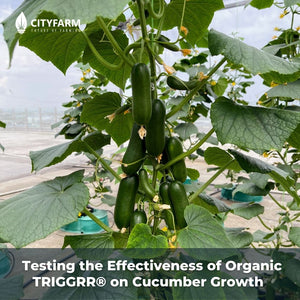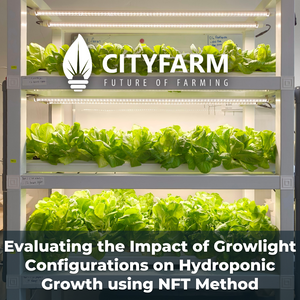[Research] Effects of Organic Matter on Plant Taste in NFT Hydroponics
![[Research] Effects of Organic Matter on Plant Taste in NFT Hydroponics](http://cityfarm.my/cdn/shop/articles/11_1_1024x.png?v=1620387023)
Effects of Organic Matter on Plant Taste in NFT Hydroponics
Introduction
There are many factors contributing to flavor in vegetables such as plant biostimulants used, nutrient composition, growing temperature, harvest maturity and post-harvest handling (Diffley, 2012).
Organic matters such as humic acid and seaweed extract are among the most widely used plant biostimulants. A plant biostimulant is a substance or microorganism that, when applied to seeds, plants, or the rhizosphere, stimulates natural processes to enhance or benefit nutrient uptake, nutrient efficiency, tolerance to abiotic stresses, or crop quality and yield (Mattson & Shahid, 2021).
Plant biostimulants are available in different forms such as humic substances and seaweed extracts. The role of the plant stimulants is to enhance the plant growth and development and strengthen the plant’s defensive system to different environmental stresses (Mattson & Shahid, 2021). In this experiment, we mainly focus on the effects of plant biostimulant, Charbon (humic acid and seaweed extract) on plant taste.
Objective
The objective of this research project is to determine the effects of Charbon on plant taste.Materials
The materials of this research project include:
- City Vertical Farm M
- Green coral’s seedlings (one-months-old)
- 4 feet CityFarm Horticulture Full Spectrum LED T8 grow lights
- Cooling fans
- EC meter
- pH meter
- Measuring cups
- Weighing scale
- Hydroponic fertilizers (A and B)
- Charbon (humic acid and seaweed extract)
Method
This experiment was carried out in the City Vertical Farm M (M farm) that consisted of 2 pieces of 4ft NFT channels at both levels. Each NFT channel was occupied by eight green coral seedlings and supplied with two 4 feet grow lights. Each level of NFT channels was occupied with 16 samples. The lighting duration was set to 12 hours per day. Both levels were equipped with one cooling fan respectively.

Figure 1: One-month-old green coral’s seedlings in the channels.
The nutrient tank for the upper level of M farm consisted of both hydroponic fertilizers (A and B) and Charbon, whereas the nutrient tank for the bottom level was only consisted of hydroponic fertilizers (A and B) and are served as the experimental control pool. 35g of Charbon was added every two weeks. Furthermore, EC and pH reading were taken from both tank at the beginning and the ending of the experiment.
There are a total of 16 samples of green coral’s seedlings at each level of M farm. The samples were harvested on day 52 along with flavor testing. The respondents randomly picked and tested five out of the 32 green coral samples. The taste of each samples was rated accordingly to the scale of 1-sweet, 2-little sweet, 3-no taste, 4-little bitter and 5-bitter.
In addition, the initial weight and final weight and final appearance of each sample were illustrated in Table 2 and Table 3 respectively. Also, the initial reading and final reading from both the EC and pH meters were recorded in Table 4. The results were recorded on 29th March of 2021 which is a total of 52 days from the stage of germination to the stage of harvest.
Results
Flavor testing


Table 1 below showed the scores of flavor testing from 5 green coral samples of both Tank A and Tank B by 10 respondents.
Table 1: Flavor testing from samples of Tank A and Tank B
|
Tank A |
Tank B |
||||||||
|
17 |
15 |
17 |
17 |
14 |
17 |
15 |
20 |
16 |
19 |
|
16 |
15 |
17 |
12 |
15 |
16 |
16 |
22 |
16 |
24 |
|
Mean: 3.1 |
Mean: 3.62 |
||||||||
Table 2 below showed the initial weight and final weight of all 32 samples of green coral (with net pot) after 52 days.
Table 2: Initial weight and final weight of samples (with net pot).
|
Sample (S) |
Tank A |
Tank B |
||
|
Initial weight (g) |
Final weight (g) |
Initial weight (g) |
Final weight (g) |
|
|
1 |
16 |
58 |
16 |
88 |
|
2 |
17 |
165 |
17 |
121 |
|
3 |
15 |
116 |
15 |
144 |
|
4 |
16 |
113 |
17 |
163 |
|
5 |
16 |
116 |
16 |
134 |
|
6 |
15 |
134 |
16 |
153 |
|
7 |
16 |
111 |
15 |
93 |
|
8 |
15 |
63 |
15 |
93 |
|
9 |
16 |
49 |
16 |
69 |
|
10 |
16 |
96 |
15 |
122 |
|
11 |
16 |
120 |
16 |
161 |
|
12 |
16 |
140 |
15 |
127 |
|
13 |
16 |
98 |
16 |
141 |
|
14 |
16 |
120 |
16 |
142 |
|
15 |
16 |
95 |
16 |
130 |
|
16 |
15 |
63 |
14 |
57 |
|
Average weight (g) |
16 |
104 |
16 |
121 |
Table 3 below showed the final appearance of all 32 samples of green coral after harvested.
Table 3: Final appearance of green coral samples after harvested.
|
Samples from Tank A |
Observation |
Samples from Tank B |
Observation |
 |
Sample 1, 8, 9, 10, 16 - Elongated, slightly twisted and low number of leaves. |
 |
Sample 1, 8, 9,10, 16 - Elongated, and low number of leaves. |
 |
Sample 5, 6 - Elongated and twisted. |

|
Sample 2, 3, 5, 7- Elongated and slightly twisted. |
 |
Sample 2, 3, 4, 7, 11, 12, 13 ,14, 15- Good in shape, compact and not twisted. |
 |
Sample 4, 6, 11, 12, 13, 14, 15 - Compact and slightly twisted. |
Table 4 below showed the initial reading and final reading from both the EC and pH meters in both tank A and tank B.
Table 4: Initial reading and final reading from both the EC and pH meters.
|
Tank A |
Tank B |
|||
|
EC (ms/cm) |
pH |
EC (ms/cm) |
pH |
|
|
Initial reading |
1.67 |
6.39 |
1.58 |
6.25 |
|
Final reading |
2.50 |
7.30 |
2.10 |
7.30 |
Discussion
Plant taste
According to the results obtained, most of the respondents rated the taste of the samples from Tank A and Tank B as no taste and little bitter respectively. Tank A consisted of both hydroponic fertilizers (A and B) and Charbon, whereas Tank B only consisted of hydroponic fertilizers (A and B). Charbon was made up of humate and seaweed extracts.
In terms of plant taste, sulfur is important in contributing to the flavor of the crops produced. Next, humate consisted of potassium. Potassium also proven have a crucial role in product quality parameter such as taste (Çalişkan & Cengiz Çalişkan, 2017). However, at the same time, humate also had the probability to decrease the amount of sulfur available to the plants (Rauscher, n.d.). Hence, if sulfur was unable to deliver to plant, this may results in no taste. Lastly, the reason of causing no taste in samples might be due to the humic acid in Charbon was chelated with the calcium in hydroponic fertilizers and resulted in precipitation. This makes the plants cannot absorb the nutrient such as potassium from humate.
Weight and final appearance of green coral samples
Results demonstrated that the samples with the addition of Charbon had a lighter weight as compared to the control. The average size of samples from Tank B was 104g which is 17g lesser than the samples from Tank A. Furthermore, result also showed that most of the samples from Tank A were good in shape, compact and not twisted whereas the samples from Tank B were compact and slightly twisted. This proved that the organic matter which is seaweed extracts in Charbon could lead to improved plant growth and quality.
EC reading and pH reading
EC stands for electrical conductivity. An EC meter measures the molar conductivity which is the potential for an electrical current to be transported through water (Klaassen, n.d.). Electrons are able to flow through the water due to the ions dissolved in the water (Klaassen, n.d.). The addition of the Charbon resulted in higher EC reading compared to the tank without Charbon. Hence, when Charbon was dissolved, the molar conductive potential for current through water was increased and thus increased the EC value.
Moreover, pH of a solution indicates the concentration of free hydrogen ions it contains (Andrew, n.d.). pH is related to nutrient availability (Andrew, n.d.). When the pH is within the optimum range, more nutrient was delivered and available to the plant roots. The result showed that the addition of the Charbon showed higher pH reading compared to the tank without Charbon. Hence, the tank consisted of Charbon had higher nutrient availability and this helped the plant to improve the nutrient uptake. However, when the pH of the nutrient solution was above 7, Ca2+, Fe2+, Mn2+, and Mg2+ would precipitate to the salts (Çalişkan & Cengiz Çalişkan, 2017). This means that the nutrients received by plants are restricted.
Conclusion
From this experiment, the results showed that the taste of the samples from Tank A and Tank B as no taste and little bitter respectively. Furthermore, the samples from Tank B are heavier than samples from Tank A. However, in terms of appearance, samples from Tank A with addition of Charbon have better appearance as compared to the control. This experiment is required to repeat for several times to obtain accurate results. Further studies need to be done on the effects of Charbon on plant taste in NFT hydroponics to support the hypothesis of this experiment.
References
Andrew. (n.d.). What is the best pH for hydroponics? Link
Çalişkan, B, & Cengiz Çalişkan, A. (2017). Potassium nutrition in plants and its interactions with other nutrients in hydroponic culture. Link
Diffley, A. (2012). Flavor – Growing vegetables. Link
Klaassen, P. (n.d.). Electrical conductivity, why it matters. Link
Mattson, N., & Shahid, M. (2021). Plant biostimulants as a tool for hydroponic vegetable production. e-Gro. 6(7), 1-7.
Rauscher, F. (n.d.). Which nutrients contribute to better-tasting homegrown fruits and vegetables? Link
- Goh Yar Yean (INTI International University)



![[Research] The Effect of Synthetic Fertilizer and Organic Fertilizer on Plant Growth (Green ribbon)](http://cityfarm.my/cdn/shop/articles/11_69_300x.png?v=1696511389)
![[ArtIcle] Urban Farming: Opportunities and Challenges](http://cityfarm.my/cdn/shop/articles/WhatsApp_Image_2023-05-18_at_14.53.55_300x.jpg?v=1684392966)
![[Article] The Future of Indoor Vertical Farming](http://cityfarm.my/cdn/shop/articles/11_ce4d60df-c15d-4168-9051-811d2f2db016_300x.png?v=1670699733)
![[Research] The Effect of Water Temperature on Plant Growth](http://cityfarm.my/cdn/shop/articles/11_43_300x.png?v=1653919657)